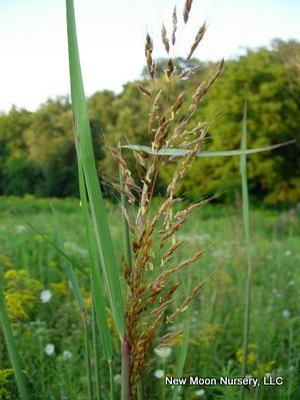Printed at http://www.newmoonnursery.com/index.cfm/

Drought tolerant, Indian grass makes a lovely ornamental grass while offering benefits of erosion control.
Sorghastrum nutans
Indian grass
Native to North America
FIRST IMPRESSIONS: Sorghastrum nutans is an elegant clump forming warm season grass. In spring and early summer, plants form low growing tufts of graceful bluish-green arching leaves. As summer progresses, the culms rise and are topped by attractive golden panicles. The leaves and seeds develop amber winter highlights. This handsome grass thrives in prairie type settings or in sunny gardens with moist, average or dry soils.
HABITAT & HARDINESS: Sorghastrum nutans ranges through most of the southern Canadian provinces and the contiguous United States except for the 5 most western states. The species is most common in the Midwestern Plains of North America.
Plants are indigenous to prairies, prairie remnants, savannas, limestone glades, serpentine barrens, grassy fens, roadsides, railroad right-of-ways, ditches and moist or dry fields.
Sorghastrum nutans is hardy from USDA Zones 2-9.
PLANT DESCRIPTION: Sorghastrum nutans is a clumping grass that produces dense leafy tufts from short rhizomes.
The arching linear leaves are pale green, dark green or bluish green with golden yellow fall tints. They are about 1/4” wide and 24” long and are borne on unbranched vertical culms.
In late summer the culms elongate and produce plume-like panicles of spikelets. The panicles are showy and 4-14” long with an oval silhouette.
Each panicle has many wiry tan branches bearing ¼” long lance shaped spikelets with ¾” curved or twisted awns. The spikelet florets have 3 large yellow stamens and 2 white feathery stigmas.
The ripe seed that follow are a metallic bronze or copper color that glimmers in the late afternoon light.
Plants maintain an upright winter habit and dried seed and foliage assume an amber hue.
This grass averages 3-5’ tall with 3’ spread but in favorable sites can reach 7’ or more.
CULTURAL & MAINTENANCE NEEDS: Sorghastrum nutans prospers in sunny sites with rich silty loam soils.
This robust grass tolerates clay, sandy and gravelly soils and thrives in alkalinity, drought, moderate salinity and seasonal flooding.
Excess shade, fertilizers or abundant water should be avoided as these conditions promote weak sprawling stems.
Plants self-seed and may need deadheading to prevent excess seedlings in small manicured gardens.
The only consistent maintenance need is to cut or burn this grass to the ground in late winter.
LANDSCAPE USES: This is a striking vertical Accent or Mass Planting for Wildlife Gardens, Prairies or Meadows. Sorghastrum nutans provides Erosion Control, Fall Color, Winter Interest, Interesting Blooms and Showy Seedheads. Plants are appropriate for Cottage Gardens, Low Maintenance Plantings, Water Wise Landscapes, Rain Gardens, Roadsides, Restoration Projects, Stormwater Management Projects and Perennial Borders.
COMPANION & UNDERSTUDY PLANTS: Try pairing with Andropogon gerardii, Asclepias tuberosa, Coreopsis tripteris, Echinacea purpurea, Eupatorium hyssopifolium, Hibiscus moscheutos, Rudbeckia subtomentosa or Schizachyrium scoparium.
Panicum virgatum has similar height, foliage and cultural needs and can be substituted if needed.
TRIVIA: Sorghastrum nutans is a dominant species of the Midwestern Tallgrass Prairies. This grass along with Andropogon gerardii, Panicum virgatum and Schizachyrium scoparium are sometimes called "The Four Horsemen of the Prairie".
Sorghastrum nutans provides seed, cover and nesting sites for birds and pollen for bees. Pepper-and-salt skipper caterpillars and deer nibble the foliage. Ranchers plant this grass as a high protein forage grass.
In winter prairie settings, Soghastrum nutans maintains an upright stance while its companion Andropogon gerardii collapses.
Height:
3-5 ftSpread:
2-3 ftSpacing:
3 ftUSDA Hardiness Zone:
2-9Bloom Color:
Green, TanSorghastrum nutans Characteristics
Attracts Wildlife
- Songbirds
Attributes
- Naturalizing
- Drought Tolerant
- Dried Flower
- Clay Soil
Exposure
- Full Sun to Partial Shade
Flowering Months
- August
Foliage Color
- Green
Grass Season
- Warm Season Grass
Growth Rate
- Fast
Juglans nigra Tolerance (Black Walnut)
- Yes
Salt Tolerance
- Low
Season of Interest (Foliage)
- Fall
- Summer
- Spring
- Winter
Soil Moisture Preference
- Dry to Moist
